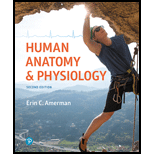
To review:
The statements given below are to be reviewed and corrected accordingly.
a. Type I alveolar cells secrete a chemical called surfactant.
b. Alveolar macrophages are squamous epithelial cells which constitute 90% of the total cells in the alveoli.
c. The respiratory membrane consists of the type II alveolar cells, the pulmonary capillaries’ endothelial cells, and their shared basal lamina.
d. The respiratory membrane must be thick to function effectively in gas exchange.
Introduction:
The respiratory system of the human beings contains nose, pharynx, larynx, trachea, bronchial tree and lungs. The alveoli are that part of the respiratory system which helps in the exchange of the gases needed by our body. The alveoli are always present in a group called alveolar sac.
Want to see the full answer?
Check out a sample textbook solution
Chapter 21 Solutions
Human Anatomy & Physiology Plus Mastering A&P with Pearson eText -- Access Card Package (2nd Edition) (What's New in Anatomy & Physiology)
- Due to its partial pressure gradient, carbon dioxide diffuses from cells into tissue fluid and into the ________; in the lungs, carbon dioxide diffuses into the ________. a. alveoli; bronchioles b. bloodstream; bronchioles c. alveoli; bloodstream d. bloodstream; alveoliarrow_forwardThe respiratory components of the medulla consist of which of the following? Dorsal respiratory group Apneustic center Ventral respiratory group Pneumotaxic center 1 only 2 only 1 and 3 only 2 and 4 onlyarrow_forwardDescribe the function of these terms and describe where they are located: main bronchus, trachea, alveoli.arrow_forward
- The respiratory system_______. a. provides body tissues with oxygen b. provides body tissues with oxygen and carbon dioxide c. establishes how many breaths are taken per minute d. provides the body with carbon dioxidearrow_forwardWHich of the following finding at the apex best explains why ventilation-perfusion ratios are higher at the apex than base of a normal upright lungs? a. Alveolar Po2 is higher b. Alveoli contains more elastin and less collagen c. Alveoli have less surfacant d. Change in pleural pressure with each breathe is higher e. Perfusion is lowerarrow_forwardWhich of the following correctly describes the transition from bronchi into smaller branches in the bronchial tree? a. More hyaline cartilage is found in the smaller passageways of the bronchial tree. b. The rings of cartilage completely disappear during the transition from the trachea into the bronchial tree. c. The lining changes from respiratory epithelium to stratified squamous epithelium. d. The amount of smooth muscle increases in the smaller passageways of the bronchial tree.arrow_forward
- All of the following are true of the airway except A. The largest piece of Cartlidge is the thyroid cartilage B. The cricoid ring is an incomplete ring C. The tracheal rings are in complete rings D. The carina is the bifurication of the trachea into a left and right primary bronchus Choose the correct answerarrow_forwardA premature infant develops progressive difficulty breathing over the first few days of life. Deficient surfactant synthesis by which of the following cell types may have contributed to the baby's respiratory problems? A. Alveolar capillary endothelial cells B. Bronchial mucous cells C. Bronchial respiratory epithelium D. Type I pneumocytes E. Type Il pneumocytesarrow_forwardAli, aged 28, normally does not suffer from asthma. However, he has an asthma attack at his work. The doctor recommends that Andrew does some pulmonary function tests to confirm his diagnosis. Part A. Explain what will happen to resistance in the airways, and how it will affect airflow during Andrew’s asthma attack. Part B. Compared to a normal FEV1/FVC ratio, what do you expect will happen to Andrew’s FEV1/FVC ratio? Explain why this occurs. Part C. Andrew has another more serious asthma attack that causes hypoventilation. Explain what effect this will have on pH, and what serious consequence could occur if left untreated.arrow_forward
- What type of epithelium lines the gas exchange surfaces of the alveoli? a. pseudostratified columnar epithelium b. ciliated columnar epithelium c. simple squamous epithelium d. simple cuboidal epithelium I believe that it is pseudostratified ciliated columnar epithelium but that is not an option so I don't know what one to choose.arrow_forwardThe source of pulmonary surfactant is:- a. the visceral pleura. b. bronchial glands. c. alveolar capillaries. d. squamous alveolar cells. e. great alveolar cellsarrow_forwardThe Respiratory System Examine an H&E slide of a transverse section of the trachea or main bronchus, and respond to the following. 1. Give the three major layers in its wall from within outwards.i.ii.ii. 2. At high power fucus on the the apical surface of the epithelium,what structures are there? 3. What is function of the apical cell surface structures? 4. Still at a high power, how many nuclear (cell) layers can you observe? 5. Why is the epithelium called pseudostratified? 6. Look for goblet cells; what three functions do mucus produced by these cells serve?i.ii.iii. 7. Besides globlet cells, what other four types of cells are present in the epithelium?I.ii.iii.iv. 8. The epithelium is supported by a lamina priopria of loose connective tissue. Which two connective tissue fibres occur in this sub-layer?i.ii. 9. The presence of seromucous glands indicates the submucosal layer. What function is served by secretions of these glands? 10. The presence of the cartilage indicates the…arrow_forward
 Human Physiology: From Cells to Systems (MindTap ...BiologyISBN:9781285866932Author:Lauralee SherwoodPublisher:Cengage Learning
Human Physiology: From Cells to Systems (MindTap ...BiologyISBN:9781285866932Author:Lauralee SherwoodPublisher:Cengage Learning Comprehensive Medical Assisting: Administrative a...NursingISBN:9781305964792Author:Wilburta Q. Lindh, Carol D. Tamparo, Barbara M. Dahl, Julie Morris, Cindy CorreaPublisher:Cengage Learning
Comprehensive Medical Assisting: Administrative a...NursingISBN:9781305964792Author:Wilburta Q. Lindh, Carol D. Tamparo, Barbara M. Dahl, Julie Morris, Cindy CorreaPublisher:Cengage Learning- Basic Clinical Lab Competencies for Respiratory C...NursingISBN:9781285244662Author:WhitePublisher:Cengage
 Cardiopulmonary Anatomy & PhysiologyBiologyISBN:9781337794909Author:Des Jardins, Terry.Publisher:Cengage Learning,
Cardiopulmonary Anatomy & PhysiologyBiologyISBN:9781337794909Author:Des Jardins, Terry.Publisher:Cengage Learning, Human Biology (MindTap Course List)BiologyISBN:9781305112100Author:Cecie Starr, Beverly McMillanPublisher:Cengage Learning
Human Biology (MindTap Course List)BiologyISBN:9781305112100Author:Cecie Starr, Beverly McMillanPublisher:Cengage Learning





